mobile View, to the German Version tap the flag


- Republic of Benin
- presidial republic
- own name: République du Bénin
- former name: Dahomey
• Flag
• Historical Flags
• Meaning/Origin of the Flag
• Coat of Arms
• Historical Coats of Arms
• Meaning/Origin of the Coat of Arms
• Aircraft Roundel
• Map
• Numbers and Facts
• History
• Origin of the Country's Name
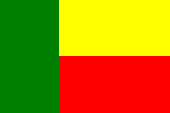
National flag,
ratio – ratio = 2:3,
Source, by: Corel Draw 4






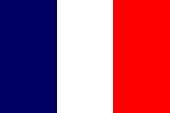
1894–1959
Flag of France,
ratio = 2:3,
Source, by: Corel Draw 4






1959–1975,
National flag,
ratio = 2:3,
Source, by: Flags of the World





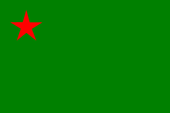
1975–1990,
National flag,
ratio = 2:3,
Source, by:
Flaggen und Wappen,
Wikipedia (DE)




From November 1959 until the 30th of November, 1975 the present day's flag was already the national flag of Dahomey. On the 30th of November, 1975 the country was renamed to Benin. The green flag with the red star, introduced on this day and retained until the 1st of August, 1990, corresponds to the colour reversal of the Revolutionary People’s Party of Benin. The green on the flag stood for agriculture, the red for revolution and socialism, and the red star for national unity. The flag of Dahomey was reintroduced on the 1st of August, 1990. It consists of a vertical green stripe near the pole and two horizontal stripes of yellow and red in the flying end of the flag.
The colours green, yellow and red are the Pan-African colours. The Pan-African-Movement had its beginnings perhaps in 1900, which wants to emphasize the common goals of all black people. The colour-triad green-yellow-red, which are used by many African and even American countries in their flags after independence, stands for the political unity of Africa, of all black People. The first country was Ghana in 1957. As the origin, the colours of Ethiopia (Abessinia), the oldest independent state in Africa, apply.
The colours yellow and green symbolize the separation between the arid, northern part of the savannas and the southern one, and the humid part of Benin with hers palm tree forest. Both parts are bonded with red, the shed blood and national unity.
Source:
Die Welt der Flaggen,
Flaggen und Wappen der Welt

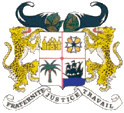
since 1990,
Coat of arms of Benin,
Source:
Corel Draw 4,
Wikipedia (D)


1975–1990,
Coat of arms of Benin,
Source:
Wikipedia (D),
Flaggen und Wappen

1964–1975,
Coat of arms of Dahomey,
Source:
Corel Draw 4,
Wikipedia (D)

The shield of the coat of arms of Benin is quartered. In the first silvery field are depicted typical homes, in the second silvery one the supreme order of the land, in the third silvery one a coconut palm, and in the fourth silvery one a black sailing ship with three masts on blue waves. Thus the quarters of the coat of arms stand for the people, a glorious history, commercial production and trade. In the centre of the shield a little red rhomb is positioned. Shield holders are two golden panthers. Above the shield are two black cornucopias which contain corncobs. On a silvery motto ribbon below the scutcheon appears the motto: "Fraternité, Justice, Travail" => "Fraternity, Justice, Labor". Today's coat of arms had already been introduced for Dahomey in 1964, and was, like the flag of Dahomey, confirmed on the 1st of August, 1990. During the years 1975–1990 the coat of arms showed a green disk, surrounded by a garland from corncobs, which were bound with a red ribbon. In the upper part of the green disk was a red five-pointed star and in the lower part, directly on the edge of the disk, the blade of a circular saw.
Source:
Die Welt der Flaggen,
Flaggen und Wappen der Welt

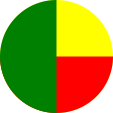
Aircraft Roundel,
Source, by: Wikipedia (EN)
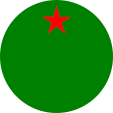
1975–1990,
Aircraft Roundel,
Source, by: Wikipedia (EN)

Location:
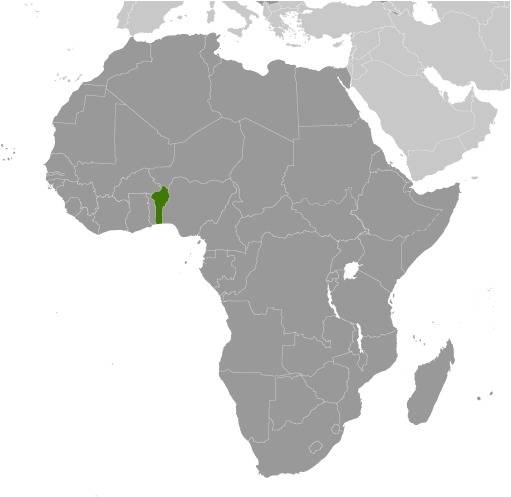
Source: CIA World Factbook
Map of the country:
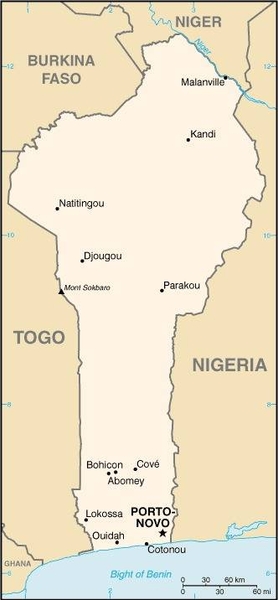
Source: CIA World Factbook

Area: 43.483 square miles
Inhabitants: 11.485.000 (2018), thereof 39% Fon, 15% Adja, 9% Bariba, 7% Fulbe, 6% Otamari
Religions: 42% Christian (mostly Roman Catholic), 28% Muslim, 17% Voodoo
Density of Population: 264 inh./sq.mi.
Capital: Porto Novo, 264.320 inh. (2013)
official Language: French
other Languages: Fon, Adja, Bariba, Yoruba, Aizo ...
Currency: CFA-Franc (FCFA) = 100 Centimes
Time Zone: GMT + 1 h
Source: Wikipedia (D)

1625 · Kingdom of Dahomey
1650 · foundation of the British base Fort William at Ouidah (Whydah, Ajuda)
1671 · foundation of the French base Fort St. Louis at Ouidah
1680 · foundation of the Portuguese base Forte de São João Baptista de Ajuda at Ouidah
1721 · the Portuguese fort of São João Baptista is assumed to Brazil
1797 · France leaves Fort St. Louis
1807 · the United Kingdom leaves Fort William
1844 · Fort São João Baptista is abandoned
1865 · Portugal re-appropriates Fort São João Baptista
1868–1893 · France establishes protectorates and colonies at the coast (Cotonou, Porto-Novo, Ouidah)
22nd of June in 1894 · founding the French colony of Dahomey
1899 · Dahomey becomes part of the colony of French West Africa
12th of April in 1958 · France grants autonomy to the Republic of Dahomey
1st of August in 1960 · France grants independence to the Republic of Dahomey
1961 · Dahomey occupies the Fort São João Baptista
1972 · military coup led by Lieutenant Colonel Kérékou
1975 · Portugal recognizes the seizure of Fort São João Baptista by Dahomey
30th of November in 1975 · renamed in People's Republic of Benin
1980 · Colonel Kérékou becomes president
1989–1990 · riots
3rd of January in 1990 · renaming in Republic of Benin, introduction of political reforms
Source:
Wikipedia (D),
World Statesmen,
Länder der Erde

The name of the country goes back to the elongated bay of Benin and to the old kingdom of Benin. It existed between 13th and 19th century, but it was in the largely placed in the area of today's Nigeria. The old name "Dahomey" (or "Dahome"), dates back to the Kingdom of Dahomey, which was placed without access to the coast between the Kingdoms of Ashantee and Joruba in the area of today's Benin. It existed between 17th and 20th century, was extremely authoritarian and extremely aggressive. Maybe that this was the reason to renounce a rename back in Dahomey in 1990.
Source:
Wikipedia (D),
Meyers Konversationslexikon via
RetroBib Retrobibliothek,
Volker Preuß


![]()























